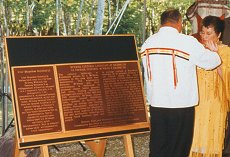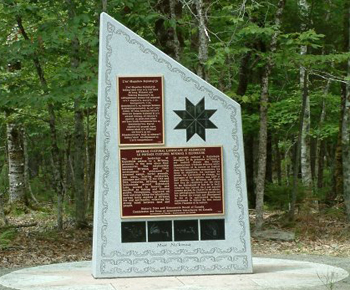National Historic Site Designation
Kejimkujik National Park and National Historic Site
In 1994, Parks Canada and the Mi’kmaq First Nation made a submission to the Historic Sites and Monuments Board of Canada recommending that Kejimkujik National Park be designated a National Historic Site of Canada. The recommendation stated that:
“...the cultural landscape of Kejimkujik National Park, which attests to 4000 years of Mi’kmaq occupancy of this area, and which includes petroglyph sites, habitation sites, fishing sites, hunting territories, travel routes and burials, is of national historic significance...”
Cultural landscapes give us a sense of place, and bring to light our relationship with the land over time. Kejimkujik National Park and National Historic Site allows us to celebrate the wonderful union of cultural landscape and natural environment, while honouring the outstanding contribution of the Mi’kmaw people to our national heritage.
Commemoration

As a result of its rich cultural landscape, Kejimkujik was designated a National Historic Site in 1995, making it the first National Park to have this dual status. Two commemorative bronze plaques – one in English and French and the other in Mi'kmaw – were created to commemorate the designation, and were unveiled on Treaty Day, October 1st, 2000. Parks Canada commissioned a monument to hold the plaques, and asked the Mi'kmaw Network to select a design. The design submitted by Jean Augustine-McIsaac was deemed most fitting. In the artist's own words:
"The form of the proposed monument was developed to represent the Mi'kmaw people and their history in the Kejimkujik area in as meaningful a way as possible. For this reason, each image used for the monument's features is drawn from the Mi'kmaw petroglyphs located within [Kejimkujik]."
Commemorative monument

The overall shape for the two-metre high monument is based on the traditional woman's peaked hat - a recurring theme in Kejimkujik's petroglyphs. Given the labour required to create these images, their frequency is a strong argument for their importance to the matriarchal Mi'kmaw culture. The monument is bordered with a repetitive curvilinear design, which was a common motif in clothing and art, and is representative of how the peaked cap would have been decorated.
The eight-pointed star adjacent to the plaques is a symbolic representation of the Mi'kmaw nation. The figures within the points represent both men and women, real and mythical, from the Mi'kmaw nation of the past. In addition, because the star is still used in contemporary Mi'kmaw culture, a link is also made between the past and the present.
Below the plaques are four framed petroglyph images, chosen to represent themes common in Mi'kmaw daily life. An image of the mythical Kulloo bird represents the rich Mi'kmaw story-telling tradition, which played an active role in their everyday life. A hunting scene features a long-vanished caribou, once a mainstay of the Mi'kmaw diet. A fishing scene depicts two men in a canoe, in pursuit of a porpoise. Finally, a single handprint, with superimposed images of male and female headdress, was chosen to represent the Mi'kmaw family unit.
* Note: the National Historic Site designation does not include the Kejimkujik Seaside.
Related links
- Date modified :